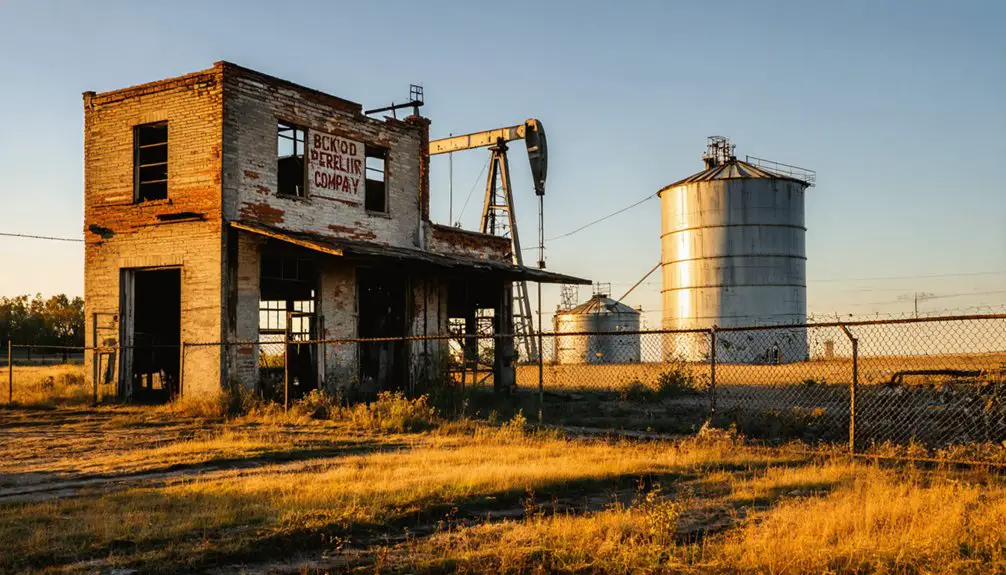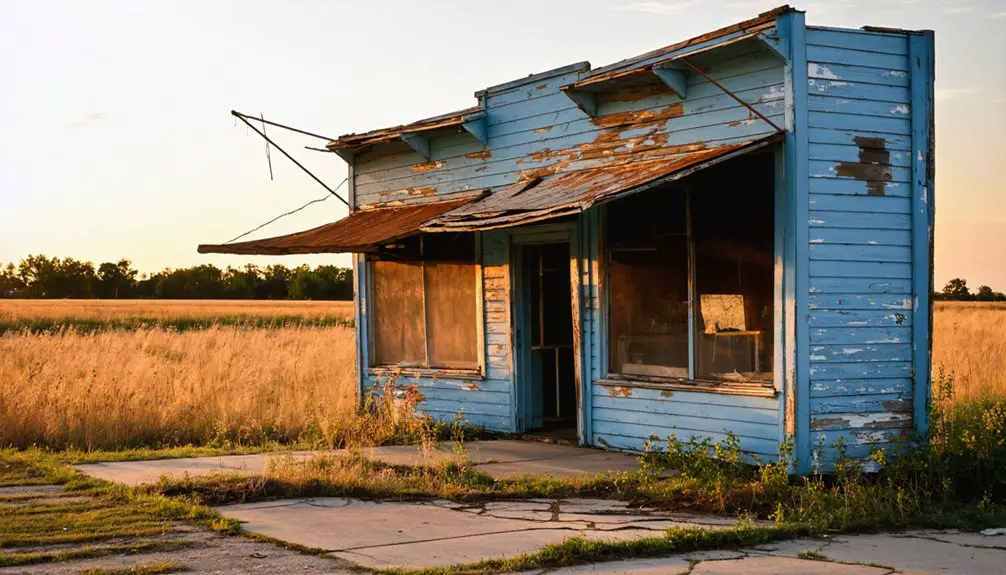You’ll find Bickford’s remnants in Roman Nose Canyon, Oklahoma, where this early 1900s company town once thrived around gypsum mining. The Roman Nose Gypsum Company built homes, a hotel, and a mill, connected by railroad lines to regional trade networks. While Lake Watonga now covers much of the mill site, you can still spot scattered foundations where workers lived until the 1920s economic downturn forced the town’s abandonment. The site’s artifacts reveal a fascinating chapter of Oklahoma’s industrial past.
Key Takeaways
- Bickford was a company town established in the early 1900s by Roman Nose Gypsum Company to exploit gypsum deposits in Oklahoma.
- The town featured a gypsum mill, worker housing, general store, hotel, and railroad connections during its peak operations.
- Economic decline began in the 1920s, leading to the closure of the mill and post office by 1927.
- The construction of Lake Watonga later submerged many remains of the mill and town infrastructure.
- Today, only scattered foundations and artifacts remain to mark the location of this former industrial mining community.
The Rise of a Company Town
When the Roman Nose Gypsum Company discovered rich gypsum deposits in Roman Nose Canyon, Oklahoma, they quickly established Bickford as a company town to capitalize on this valuable resource.
The company’s growth transformed the canyon into a bustling industrial hub, building a large gypsum mill and multiple housing units for workers. Located in Staffordshire County, the area had a rich history of industrial development. The first general merchandise store Eltermen and Company served the growing workforce population. You’d find the town’s industrial heritage reflected in every aspect of its development, from the strategically placed railroad line that shipped gypsum products to distant markets, to the company-built hotel that housed employees.
Life in Roman Nose Canyon
Life in Roman Nose Canyon painted a rich tapestry of cultural intersections and daily struggles.
You’d find Native American heritage deeply woven into the landscape, where Indigenous tribes once made their homes along Bitter Creek before settlers arrived. The Cronkhite family emerged as prominent figures, establishing a ranch and gypsum mill that transformed the canyon’s character. Chief Henry Roman Nose and his people left an enduring legacy in the region’s history.
As you’d explore the canyon during its heyday, you’d discover a bustling community where mining families lived alongside industrial operations. The 40-foot dam created a recreational lake, while the Cronkhites’ ambitious resort plans added another layer to canyon life. The lake would later become Boecher Lake and remain a centerpiece of outdoor activities.
The social fabric included fascinating encounters with outlaws, while the clash between Native American traditions and settler expansion left lasting marks on the community’s identity.
Gypsum Mining Operations
The Roman Nose Gypsum Company transformed Bickford into a thriving industrial hub by establishing extensive mining infrastructure in the early 1900s.
You’ll find that gypsum extraction focused on thick mineral deposits in Roman Nose Canyon, perfect for manufacturing cement, plaster, and drywall products. The company’s mining techniques evolved markedly with the installation of specialized board machines by 1917, marking a shift from traditional sacket board to modern sheetrock panels.
To support these operations, they built a thorough facility including a large milling plant, railroad connections, and water pipelines. A robust company town of 1,000 developed around the mining operations, complete with homes, schools, and stores for workers and their families.
The quality of Bickford’s gypsum deposits made them particularly valuable for white plaster products, driving the town’s economy until the 1920s when economic pressures forced the mill’s closure. The Civilian Conservation Corps later removed the remaining mill structures during the Great Depression cleanup efforts.
Railroad and Transportation Hub
Looking beyond Bickford’s gypsum operations, you’ll find the railroad line served as the town’s crucial commercial lifeline, enabling the loading and shipping of processed gypsum products to distant markets.
The rail connection, established during Oklahoma’s broader period of railroad expansion in the late 19th and early 20th centuries, transformed this remote location into a specialized transportation hub within Blaine County.
You can trace how the railroad’s presence shaped Bickford’s development, as it facilitated the movement of not just industrial materials but also indispensable supplies for the town’s inhabitants.
The town’s rail infrastructure was part of Oklahoma’s extensive growth in rail networks, which expanded from 289 miles of track in 1880 to reach over 6,500 miles by 1920.
Rail Line Construction
Following federal treaties in 1866 that compelled Native American tribes to permit railroad expansion, rail development transformed Oklahoma’s Indian Territory into an important transportation network. The Missouri, Kansas and Texas Railroad led this transformation, becoming the first to cross the territory in 1870, while the Atlantic & Pacific Railroad created essential east-west connections by 1871. Before the arrival of railroads, the region relied heavily on primitive dirt roads for transportation.
You’ll find that this railroad expansion served as both an economic control mechanism over Native American tribes and a catalyst for regional development.
- Foreign investors from Britain, Germany, and the Netherlands provided critical funding for rail construction
- Rail routes strategically followed established trade paths and cattle trails
- Infrastructure upgrades enabled heavier freight loads through challenging terrain
The rail system’s growth reshaped Oklahoma’s landscape, connecting remote towns like Bickford to larger markets and establishing important transportation corridors for commerce.
Freight Loading Operations
As rail lines expanded through Bickford, freight loading operations emerged as a cornerstone of the town’s economic activity.
You’d find a bustling hub of freight handling activity, where loading docks, warehouses, and stock pens facilitated the movement of diverse commodities. The town’s facilities adapted to handle everything from local produce to coal and lumber. Like other towns needing clear navigation systems, proper signage and organization helped workers efficiently direct shipments to their destinations.
Loading techniques evolved from simple manual methods to more sophisticated operations using mechanical equipment. You could’ve seen workers using specialized chutes and hoppers for bulk materials, while cranes helped with heavier loads. Similar to the Oklahoma Railway system, the freight operations supported both local and regional transportation needs.
The railroad’s team tracks and sidings enabled efficient freight car marshaling, connecting Bickford’s agricultural producers and industries to larger markets. This infrastructure supported the town’s role as a minor regional freight hub, linking smaller communities to major rail networks.
Transportation Network Impact
When the Missouri, Kansas & Texas Railroad first penetrated Indian Territory in 1870, it established essential north-south routes that would later shape Bickford’s destiny as a transportation hub.
Railroad expansion brought unprecedented economic opportunities to the region, transforming Bickford from undeveloped land into a bustling company town centered around the Roman Nose Gypsum Company.
You’ll find that Bickford’s strategic rail connection played three significant roles:
- Connected local gypsum production to national markets, enabling bulk shipment of raw and finished materials
- Supported the town’s infrastructure development, including homes, hotels, and commissaries
- Positioned Bickford within a larger regional trade network linking Kansas, Texas, and Arkansas
Unfortunately, when rail transportation declined in the 1920s, Bickford’s fate was sealed, leading to its eventual abandonment.
Daily Life and Community
Life in Bickford revolved around the Roman Nose Gypsum Company, which provided not just employment but the entire framework for the community’s existence.
You’d find workers and their families living in company-built homes, getting their daily supplies from the commissaries, and relying on the town’s water pipeline system for their basic needs.
Community gatherings often centered around the hotel, which served as both lodging for visitors and a social hub.
Your daily routines would’ve been dictated by the mill’s schedule, with the railroad bringing in supplies and carrying out gypsum products.
Even the local post office, established in 1904, kept you connected to the outside world.
It’s worth noting that occasional visits from outlaws like Jesse James added an element of frontier excitement to this otherwise orderly company town.
Industrial Legacy and Impact

You’ll find that Bickford’s gypsum operations reflected the broader technological shifts in early 20th-century mining, evolving from basic extraction methods to more mechanized processes.
The town’s industrial activities created economic reverberations throughout Blaine County, spurring growth in construction supply chains and transportation networks.
The Roman Nose Gypsum Company’s investments in rail infrastructure and milling equipment demonstrated the rapid industrialization that transformed Oklahoma’s rural landscapes during this period.
Mining Technology Evolution
Throughout the late 19th and early 20th centuries, mining technology in Bickford underwent dramatic transformations that revolutionized mineral extraction methods.
You’d have seen early techniques evolve from basic hand-drilling and black powder blasting to sophisticated mechanization advances that shaped the region’s mining industry. As operations expanded, technological improvements brought safer, more efficient production methods.
- The introduction of steam power and electricity between 1880-1900 transformed underground mining operations.
- Mining machinery innovations like conveyor belts and continuous miners boosted production efficiency.
- Safety innovations reduced worker risks while increasing coal extraction capabilities.
The shift from manual labor to mechanized mining operations marked a turning point in Bickford’s industrial development, setting new standards for mineral extraction while fundamentally changing the environmental impact of mining activities in the area.
Economic Ripple Effects
When the Roman Nose Gypsum Company established Bickford in the early 1900s, it created an economic ecosystem that extended far beyond the town’s borders.
You’ll find that the gypsum mill’s operations supported a complex network of businesses, from commissaries and hotels to railroad services and construction supply chains throughout Oklahoma.
The town’s economic vulnerability became apparent when market fluctuations forced the mill’s closure in the 1920s.
You can trace how this shutdown triggered a domino effect: workers migrated away, local businesses collapsed, and regional consumer spending plummeted.
The ripples spread further as railroad services declined and construction material supply chains were disrupted.
The impact wasn’t just local – it affected building markets across Oklahoma, demonstrating how deeply integrated Bickford’s industrial operations had become in the regional economy.
The Final Years
As economic troubles gripped the region in the 1920s, Bickford’s fate was sealed by the closure of its lifeblood – the Roman Nose Gypsum Company’s mill. The final decline happened swiftly as residents abandoned their homes, and the economic downturn forced the post office to close in 1927.
The once-bustling company town became another casualty of Oklahoma’s boom-and-bust cycle.
- Infrastructure crumbled as the railroad ceased operations, pipelines fell into disuse, and buildings deteriorated beyond repair.
- Lake Watonga’s construction submerged many mill remains, while CCC workers cleared other ruins during the Great Depression.
- Today, you’ll find only scattered foundations, open cisterns, and small artifacts marking where this mining community once thrived.
You can still sense echoes of Bickford’s glory days in the hazardous remnants that dot the landscape.
What Remains Today

Despite its once-bustling industrial presence, modern-day Bickford has virtually vanished from Oklahoma’s landscape.
You’ll find no intact buildings, surviving industrial artifacts, or visible foundations from the Roman Nose Gypsum Company‘s operations that once defined this community. The post office, hotel, and worker homes that served the town until 1927 have completely disappeared.
Today, the site’s only markers are its environmental features – the gypsum-rich walls of Roman Nose Canyon and its location two miles north of Watonga Lake.
The surrounding terrain remains largely unchanged since the town’s abandonment, with nature reclaiming the land where industrial activity once thrived.
While Bickford lives on in historical records, its physical remnants have faded into the Oklahoma countryside, leaving little trace of its early 20th-century prominence.
Historical Significance in Oklahoma Mining
Bickford’s role in Oklahoma’s mining history represents a distinctive chapter in the state’s industrial development, diverging from the coal-dominated narratives of eastern Oklahoma.
Unlike the deadly coal mines that shaped mining regulations across the state, Bickford’s gypsum operations faced fewer catastrophic incidents but still contributed to community responses toward mining safety.
- You’ll find Bickford’s legacy intertwined with the railroad infrastructure that once connected it to broader markets, showcasing how transportation networks determined a mining town’s fate.
- You can trace the town’s significance through its unique position as both an industrial hub and an outlaw haven, attracting figures like Jesse James.
- You’ll recognize how Bickford’s boom-and-bust cycle mirrors the broader story of resource-dependent communities in early Oklahoma, where economic survival hinged on mineral wealth.
Frequently Asked Questions
Are There Any Known Accidents or Deaths From the Gypsum Mining Operations?
While historical accidents in Oklahoma mining are documented, you’ll find limited records specifically mentioning deaths at Bickford’s gypsum operations, though mining safety hazards existed throughout the state’s mineral extraction industries.
What Happened to the Railroad Tracks and Infrastructure After Abandonment?
After the mill’s 1920s closure, you’ll find most tracks were dismantled or submerged by Lake Watonga. Railroad history shows the main line’s conversion into Roman Nose State Park’s upper road, while other infrastructure vanished.
Can Visitors Legally Explore the Bickford Ghost Town Site Today?
You’ll need to confirm local ghost town regulations and secure permission first, as visitor access depends on current land ownership. The site’s likely on private property requiring landowner approval.
Were Any Notable People or Famous Residents Associated With Bickford?
Truth be told, you won’t find any famous residents of historical significance here. While outlaws like Jesse James allegedly visited for drinks, no notable people permanently called Bickford their home.
Did Any Paranormal Activity or Ghost Stories Originate From Abandoned Bickford?
You won’t find documented haunting experiences or local legends from Bickford’s ruins. Unlike other Oklahoma ghost towns, there’s no historical record of paranormal activity at this former mining community.
References
- https://en.wikipedia.org/wiki/Bickford
- https://en.wikipedia.org/wiki/List_of_ghost_towns_in_Oklahoma
- https://www.okhistory.org/publications/enc/entry?entry=GH002
- https://kids.kiddle.co/List_of_ghost_towns_in_Oklahoma
- https://www.ghosttowns.com/states/ok/bickford.html
- https://canadiancountymuseum.com/history-of-el-reno/
- http://www.jacksonjane.com/race-and-the-wild-west.html
- https://meador.org/2010/11/15/roman-nose/
- https://highcallministries.org/ranch/
- https://postalmuseum.si.edu/exhibition/indians-at-the-post-office-murals-encounter/roman-nose-canyon



